Promoting Equality and Inclusion in Health and Social Care: Unit 10
VerifiedAdded on 2023/01/05
|5
|1398
|40
Homework Assignment
AI Summary
This assignment explores the concepts of diversity, equality, and inclusion within health, social care, and children's and young people's settings. It defines these terms and examines the potential effects of discrimination, emphasizing the importance of inclusive practices in promoting equality. The assignment details relevant legislation and codes of practice, illustrating how to interact respectfully with individuals' beliefs, cultures, values, and preferences. It demonstrates actions that model inclusive practice and provides guidance on supporting others to promote equality and rights, as well as how to effectively challenge discrimination to promote change. The student provides examples and practical approaches to ensure a safe and inclusive environment, highlighting the significance of respecting individual differences and promoting equitable opportunities.
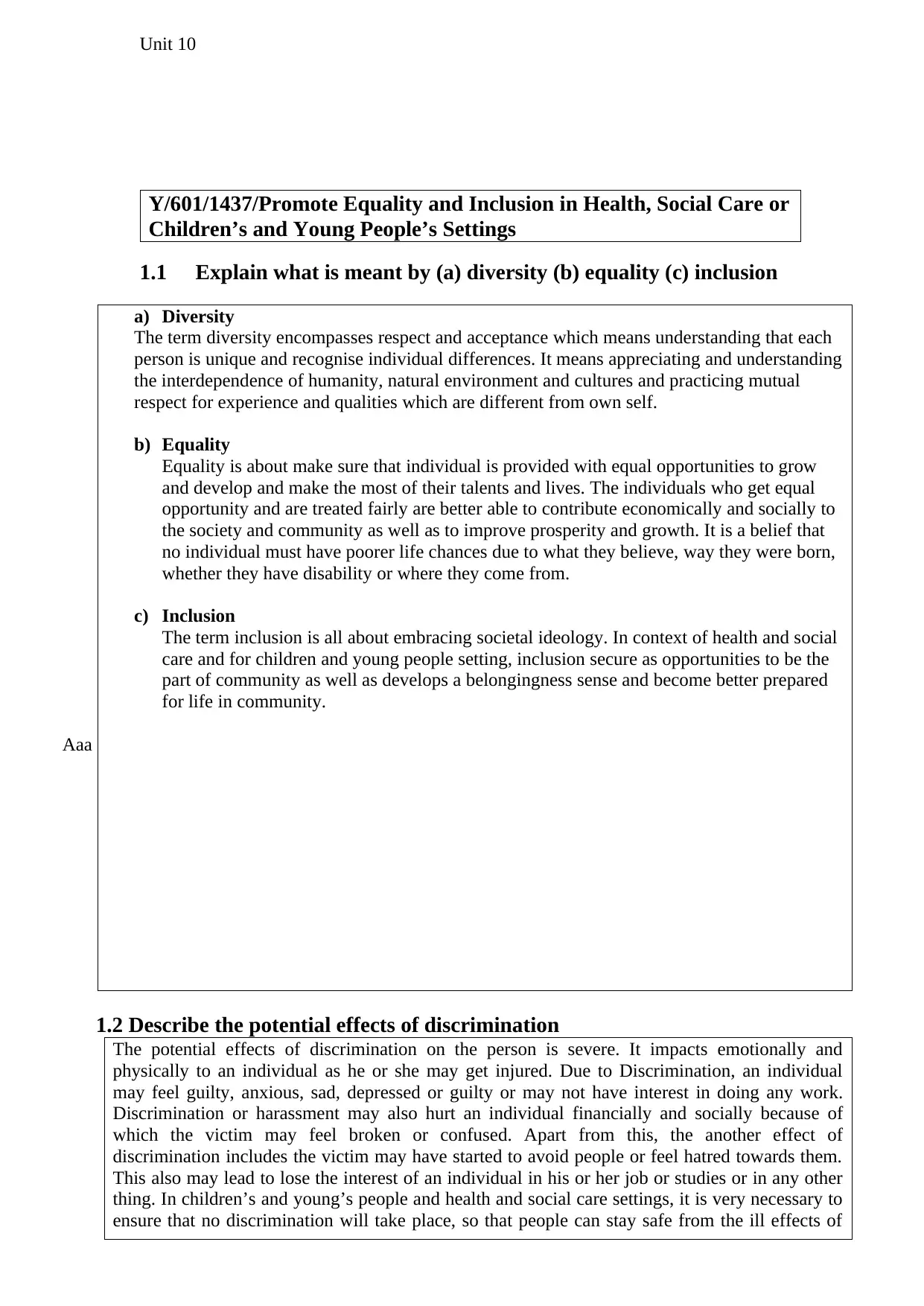
Unit 10
Y/601/1437/Promote Equality and Inclusion in Health, Social Care or
Children’s and Young People’s Settings
1.1 Explain what is meant by (a) diversity (b) equality (c) inclusion
a) Diversity
The term diversity encompasses respect and acceptance which means understanding that each
person is unique and recognise individual differences. It means appreciating and understanding
the interdependence of humanity, natural environment and cultures and practicing mutual
respect for experience and qualities which are different from own self.
b) Equality
Equality is about make sure that individual is provided with equal opportunities to grow
and develop and make the most of their talents and lives. The individuals who get equal
opportunity and are treated fairly are better able to contribute economically and socially to
the society and community as well as to improve prosperity and growth. It is a belief that
no individual must have poorer life chances due to what they believe, way they were born,
whether they have disability or where they come from.
c) Inclusion
The term inclusion is all about embracing societal ideology. In context of health and social
care and for children and young people setting, inclusion secure as opportunities to be the
part of community as well as develops a belongingness sense and become better prepared
for life in community.
Aaa
1.2 Describe the potential effects of discrimination
The potential effects of discrimination on the person is severe. It impacts emotionally and
physically to an individual as he or she may get injured. Due to Discrimination, an individual
may feel guilty, anxious, sad, depressed or guilty or may not have interest in doing any work.
Discrimination or harassment may also hurt an individual financially and socially because of
which the victim may feel broken or confused. Apart from this, the another effect of
discrimination includes the victim may have started to avoid people or feel hatred towards them.
This also may lead to lose the interest of an individual in his or her job or studies or in any other
thing. In children’s and young’s people and health and social care settings, it is very necessary to
ensure that no discrimination will take place, so that people can stay safe from the ill effects of
Y/601/1437/Promote Equality and Inclusion in Health, Social Care or
Children’s and Young People’s Settings
1.1 Explain what is meant by (a) diversity (b) equality (c) inclusion
a) Diversity
The term diversity encompasses respect and acceptance which means understanding that each
person is unique and recognise individual differences. It means appreciating and understanding
the interdependence of humanity, natural environment and cultures and practicing mutual
respect for experience and qualities which are different from own self.
b) Equality
Equality is about make sure that individual is provided with equal opportunities to grow
and develop and make the most of their talents and lives. The individuals who get equal
opportunity and are treated fairly are better able to contribute economically and socially to
the society and community as well as to improve prosperity and growth. It is a belief that
no individual must have poorer life chances due to what they believe, way they were born,
whether they have disability or where they come from.
c) Inclusion
The term inclusion is all about embracing societal ideology. In context of health and social
care and for children and young people setting, inclusion secure as opportunities to be the
part of community as well as develops a belongingness sense and become better prepared
for life in community.
Aaa
1.2 Describe the potential effects of discrimination
The potential effects of discrimination on the person is severe. It impacts emotionally and
physically to an individual as he or she may get injured. Due to Discrimination, an individual
may feel guilty, anxious, sad, depressed or guilty or may not have interest in doing any work.
Discrimination or harassment may also hurt an individual financially and socially because of
which the victim may feel broken or confused. Apart from this, the another effect of
discrimination includes the victim may have started to avoid people or feel hatred towards them.
This also may lead to lose the interest of an individual in his or her job or studies or in any other
thing. In children’s and young’s people and health and social care settings, it is very necessary to
ensure that no discrimination will take place, so that people can stay safe from the ill effects of
Paraphrase This Document
Need a fresh take? Get an instant paraphrase of this document with our AI Paraphraser
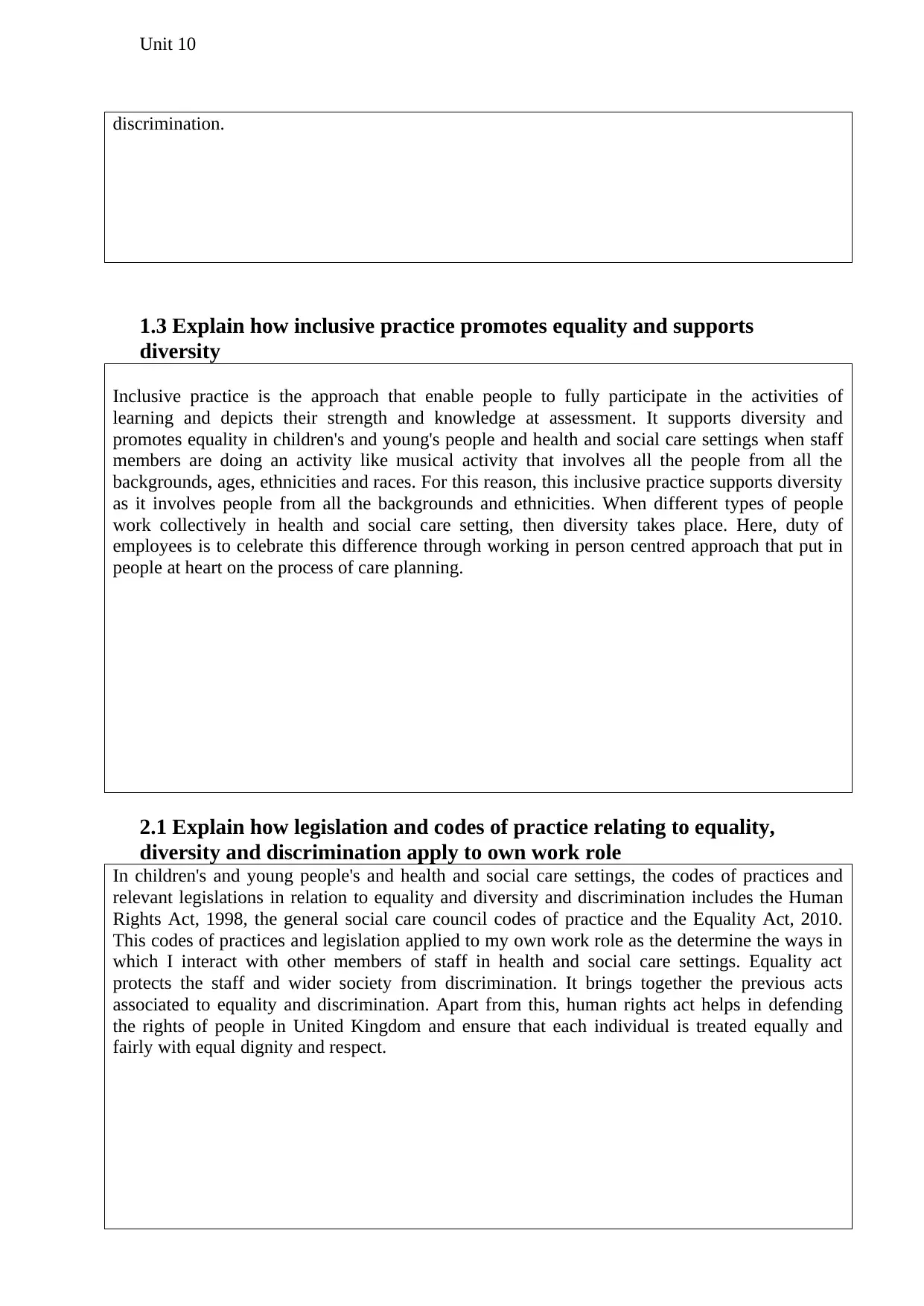
Unit 10
discrimination.
1.3 Explain how inclusive practice promotes equality and supports
diversity
Inclusive practice is the approach that enable people to fully participate in the activities of
learning and depicts their strength and knowledge at assessment. It supports diversity and
promotes equality in children's and young's people and health and social care settings when staff
members are doing an activity like musical activity that involves all the people from all the
backgrounds, ages, ethnicities and races. For this reason, this inclusive practice supports diversity
as it involves people from all the backgrounds and ethnicities. When different types of people
work collectively in health and social care setting, then diversity takes place. Here, duty of
employees is to celebrate this difference through working in person centred approach that put in
people at heart on the process of care planning.
2.1 Explain how legislation and codes of practice relating to equality,
diversity and discrimination apply to own work role
In children's and young people's and health and social care settings, the codes of practices and
relevant legislations in relation to equality and diversity and discrimination includes the Human
Rights Act, 1998, the general social care council codes of practice and the Equality Act, 2010.
This codes of practices and legislation applied to my own work role as the determine the ways in
which I interact with other members of staff in health and social care settings. Equality act
protects the staff and wider society from discrimination. It brings together the previous acts
associated to equality and discrimination. Apart from this, human rights act helps in defending
the rights of people in United Kingdom and ensure that each individual is treated equally and
fairly with equal dignity and respect.
discrimination.
1.3 Explain how inclusive practice promotes equality and supports
diversity
Inclusive practice is the approach that enable people to fully participate in the activities of
learning and depicts their strength and knowledge at assessment. It supports diversity and
promotes equality in children's and young's people and health and social care settings when staff
members are doing an activity like musical activity that involves all the people from all the
backgrounds, ages, ethnicities and races. For this reason, this inclusive practice supports diversity
as it involves people from all the backgrounds and ethnicities. When different types of people
work collectively in health and social care setting, then diversity takes place. Here, duty of
employees is to celebrate this difference through working in person centred approach that put in
people at heart on the process of care planning.
2.1 Explain how legislation and codes of practice relating to equality,
diversity and discrimination apply to own work role
In children's and young people's and health and social care settings, the codes of practices and
relevant legislations in relation to equality and diversity and discrimination includes the Human
Rights Act, 1998, the general social care council codes of practice and the Equality Act, 2010.
This codes of practices and legislation applied to my own work role as the determine the ways in
which I interact with other members of staff in health and social care settings. Equality act
protects the staff and wider society from discrimination. It brings together the previous acts
associated to equality and discrimination. Apart from this, human rights act helps in defending
the rights of people in United Kingdom and ensure that each individual is treated equally and
fairly with equal dignity and respect.
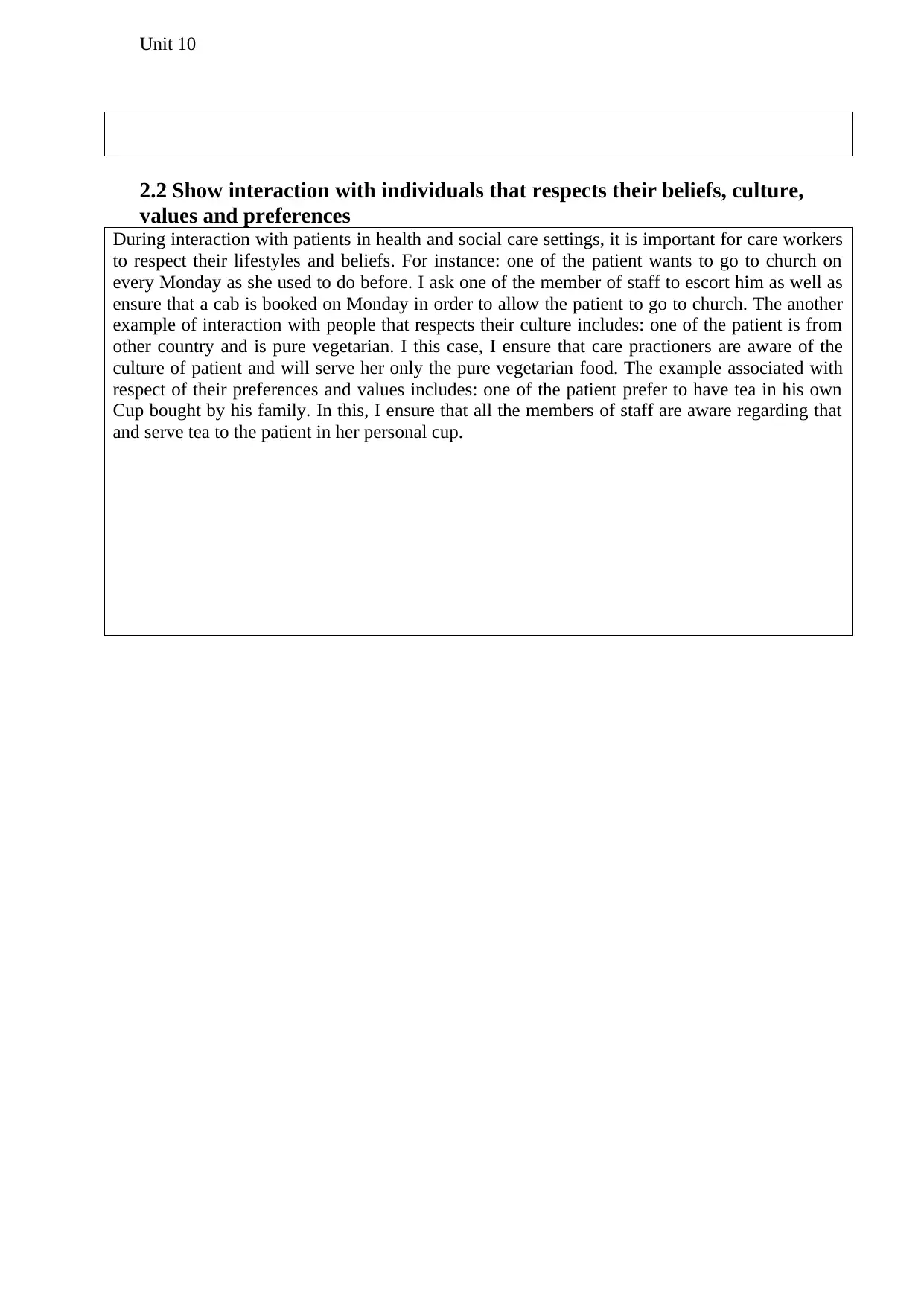
Unit 10
2.2 Show interaction with individuals that respects their beliefs, culture,
values and preferences
During interaction with patients in health and social care settings, it is important for care workers
to respect their lifestyles and beliefs. For instance: one of the patient wants to go to church on
every Monday as she used to do before. I ask one of the member of staff to escort him as well as
ensure that a cab is booked on Monday in order to allow the patient to go to church. The another
example of interaction with people that respects their culture includes: one of the patient is from
other country and is pure vegetarian. I this case, I ensure that care practioners are aware of the
culture of patient and will serve her only the pure vegetarian food. The example associated with
respect of their preferences and values includes: one of the patient prefer to have tea in his own
Cup bought by his family. In this, I ensure that all the members of staff are aware regarding that
and serve tea to the patient in her personal cup.
2.2 Show interaction with individuals that respects their beliefs, culture,
values and preferences
During interaction with patients in health and social care settings, it is important for care workers
to respect their lifestyles and beliefs. For instance: one of the patient wants to go to church on
every Monday as she used to do before. I ask one of the member of staff to escort him as well as
ensure that a cab is booked on Monday in order to allow the patient to go to church. The another
example of interaction with people that respects their culture includes: one of the patient is from
other country and is pure vegetarian. I this case, I ensure that care practioners are aware of the
culture of patient and will serve her only the pure vegetarian food. The example associated with
respect of their preferences and values includes: one of the patient prefer to have tea in his own
Cup bought by his family. In this, I ensure that all the members of staff are aware regarding that
and serve tea to the patient in her personal cup.
⊘ This is a preview!⊘
Do you want full access?
Subscribe today to unlock all pages.

Trusted by 1+ million students worldwide
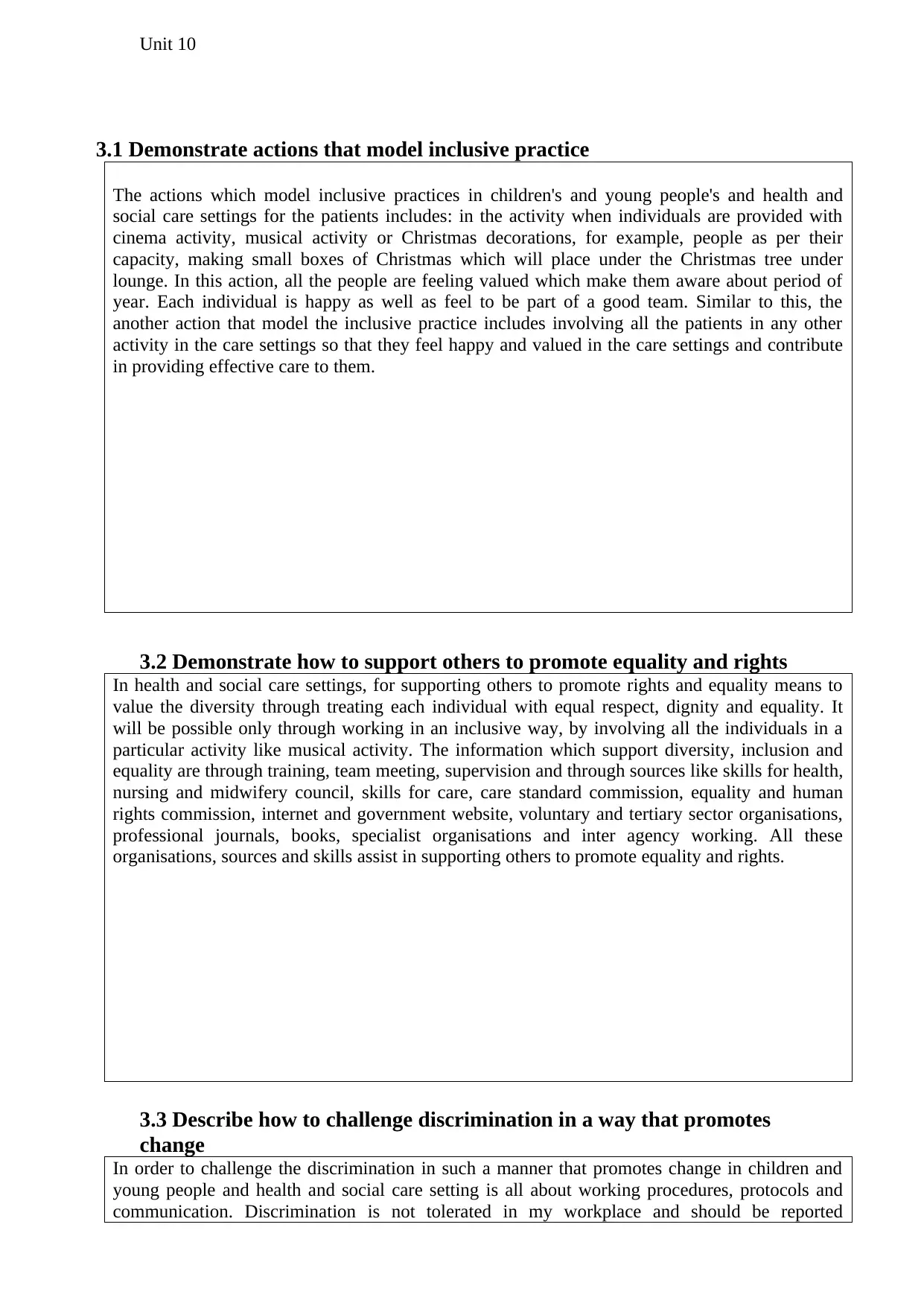
Unit 10
3.1 Demonstrate actions that model inclusive practice
The actions which model inclusive practices in children's and young people's and health and
social care settings for the patients includes: in the activity when individuals are provided with
cinema activity, musical activity or Christmas decorations, for example, people as per their
capacity, making small boxes of Christmas which will place under the Christmas tree under
lounge. In this action, all the people are feeling valued which make them aware about period of
year. Each individual is happy as well as feel to be part of a good team. Similar to this, the
another action that model the inclusive practice includes involving all the patients in any other
activity in the care settings so that they feel happy and valued in the care settings and contribute
in providing effective care to them.
3.2 Demonstrate how to support others to promote equality and rights
In health and social care settings, for supporting others to promote rights and equality means to
value the diversity through treating each individual with equal respect, dignity and equality. It
will be possible only through working in an inclusive way, by involving all the individuals in a
particular activity like musical activity. The information which support diversity, inclusion and
equality are through training, team meeting, supervision and through sources like skills for health,
nursing and midwifery council, skills for care, care standard commission, equality and human
rights commission, internet and government website, voluntary and tertiary sector organisations,
professional journals, books, specialist organisations and inter agency working. All these
organisations, sources and skills assist in supporting others to promote equality and rights.
3.3 Describe how to challenge discrimination in a way that promotes
change
In order to challenge the discrimination in such a manner that promotes change in children and
young people and health and social care setting is all about working procedures, protocols and
communication. Discrimination is not tolerated in my workplace and should be reported
3.1 Demonstrate actions that model inclusive practice
The actions which model inclusive practices in children's and young people's and health and
social care settings for the patients includes: in the activity when individuals are provided with
cinema activity, musical activity or Christmas decorations, for example, people as per their
capacity, making small boxes of Christmas which will place under the Christmas tree under
lounge. In this action, all the people are feeling valued which make them aware about period of
year. Each individual is happy as well as feel to be part of a good team. Similar to this, the
another action that model the inclusive practice includes involving all the patients in any other
activity in the care settings so that they feel happy and valued in the care settings and contribute
in providing effective care to them.
3.2 Demonstrate how to support others to promote equality and rights
In health and social care settings, for supporting others to promote rights and equality means to
value the diversity through treating each individual with equal respect, dignity and equality. It
will be possible only through working in an inclusive way, by involving all the individuals in a
particular activity like musical activity. The information which support diversity, inclusion and
equality are through training, team meeting, supervision and through sources like skills for health,
nursing and midwifery council, skills for care, care standard commission, equality and human
rights commission, internet and government website, voluntary and tertiary sector organisations,
professional journals, books, specialist organisations and inter agency working. All these
organisations, sources and skills assist in supporting others to promote equality and rights.
3.3 Describe how to challenge discrimination in a way that promotes
change
In order to challenge the discrimination in such a manner that promotes change in children and
young people and health and social care setting is all about working procedures, protocols and
communication. Discrimination is not tolerated in my workplace and should be reported
Paraphrase This Document
Need a fresh take? Get an instant paraphrase of this document with our AI Paraphraser
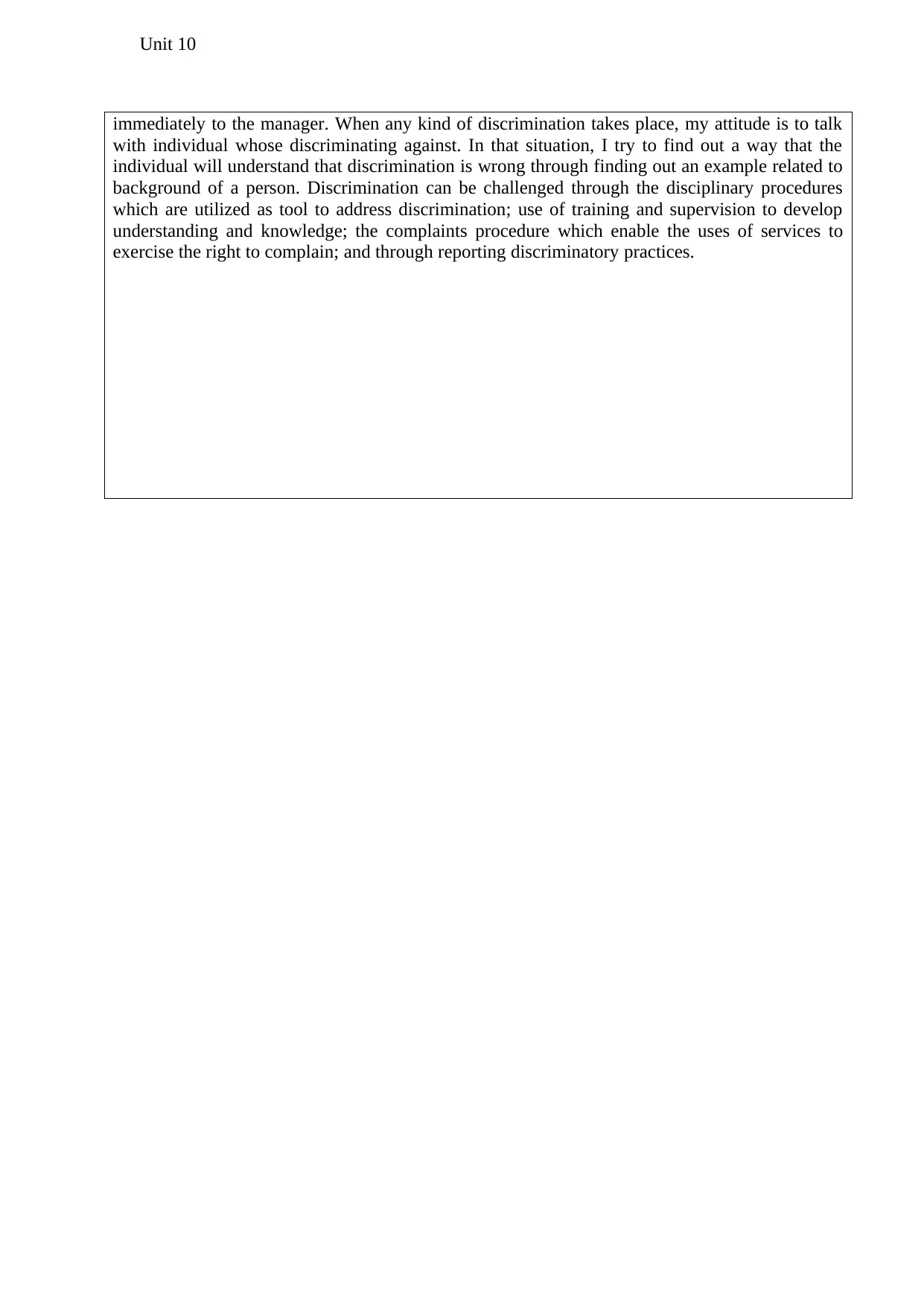
Unit 10
immediately to the manager. When any kind of discrimination takes place, my attitude is to talk
with individual whose discriminating against. In that situation, I try to find out a way that the
individual will understand that discrimination is wrong through finding out an example related to
background of a person. Discrimination can be challenged through the disciplinary procedures
which are utilized as tool to address discrimination; use of training and supervision to develop
understanding and knowledge; the complaints procedure which enable the uses of services to
exercise the right to complain; and through reporting discriminatory practices.
immediately to the manager. When any kind of discrimination takes place, my attitude is to talk
with individual whose discriminating against. In that situation, I try to find out a way that the
individual will understand that discrimination is wrong through finding out an example related to
background of a person. Discrimination can be challenged through the disciplinary procedures
which are utilized as tool to address discrimination; use of training and supervision to develop
understanding and knowledge; the complaints procedure which enable the uses of services to
exercise the right to complain; and through reporting discriminatory practices.
1 out of 5
Related Documents
Your All-in-One AI-Powered Toolkit for Academic Success.
+13062052269
info@desklib.com
Available 24*7 on WhatsApp / Email
![[object Object]](/_next/static/media/star-bottom.7253800d.svg)
Unlock your academic potential
Copyright © 2020–2025 A2Z Services. All Rights Reserved. Developed and managed by ZUCOL.



